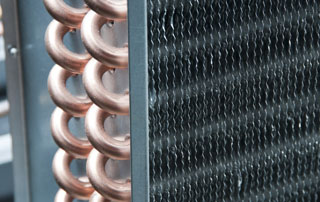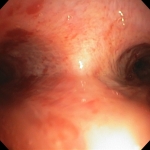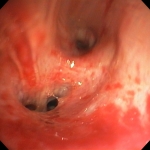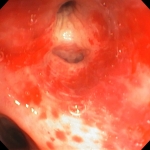It is hard to top the enjoyment of traveling the back roads in an RV. But just like boat, the constant maintenance can take a lot of the joy it. Things are constantly breaking, and the time you spend working on the RV is often more than you spend behind the wheel or camping out. This didn’t bother our patient, but unfortunately during one of his repairs he suffered a serious injury.
He had spent the last several weekends preparing his vehicle for the summer travels across the upper plain states. The refrigerator had not been cooling properly during his last trip, and he was determined to get it working. He felt for sure it was a coil in the boiler. Working alone, with the doors closed mind you, he carefully disassembled it. All of a sudden he was hit with with an envelope of noxious gas. He would tell us later he instantly knew the smell — ammonia.
He managed to get out of the door but stumbled down onto the driveway. He couldn’t stop coughing and became very short of breath. By the time he reached the hospital he was hypoxic and in significant respiratory distress. He was intubated and admitted to the ICU.
How RV Ammonia Refrigerators Works
There are 2 brands of refrigerators commonly found in RVs:
- Dometic RV refrigerator
- Norcold RV refrigerator
Both operate under the same principles. A sealed cooling element is heated either with a gas flame or an electric heating element. The cooling unit amounts to a series of tubes filled with an ammonia-based liquid. As heat is applied, the fluid circulates through the cooling unit drawing the heat out of the refrigerator.
Refrigerant grade anhydrous ammonia is a clear, colorless liquid or gas, free from visible impurities. It is at least 99.95 percent pure ammonia. Water cannot have a content above 33 parts per million (ppm) and oil cannot have a content above 2 ppm. Preserving the purity of the ammonia is essential to ensure proper function of the refrigeration system.
A strong ammonia smell inside the box, would indicate a leak in the evaporator section. If the unit has leaked for an extended amount of time the ammonia smell may no longer be present but you will probably hear a gurgling sound coming from the back of your refrigerator a few minutes after you turn it on.
Mechanism of injury
Inhalation of noxious gases and fumes, including nitric acid (solution of NO2 in water), sulfur dioxide (SO2), chlorine gas (Cl), and ammonia (NH3) can lead to acute injury by direct toxic affects on the oropharynx, larynx, trachea, and bronchial structures. This can cause mucosal sloughing and hemorrhage, which often manifests itself as coughing and hemoptysis.
However, even with relatively minor airway injury, the gases can condense and pool in the alveoli obliterating the capability for gas exchange resulting in further tissue damage and hypoxia. This can develop into ARDS (noncardiogenic pulmonary edema), irritant-induced asthma, or delayed onset of constrictive bronchiolitis (also known as bronchiolitis obliterans).
Bronchoscopy after ammonia inhalation
Our patient underwent direct laryngoscopy which demonstrated normal oropharynx and hypopharynx mucosa. On bronchoscopy he had moderate diffuse mucosal injury but only scant clear secretions.
The patient did well. He was observed on mechanical ventilation for 24 hours, with do indication of increasing ventilator support requirements or development of pulmonary infiltrates on chest radiograph and lung ultrasound. He is being followed in Pulmonary Clinic for delayed effects.




Very nice Charles, thanks.
Hi
Did the ammonia leak into your camper like it did mine. Dometic has denied the fact the ammonia can come into the camper. The fridge has two huge holes around the tabs where you screw it to the cabinet and also you can see daylight from outside showing under the bottom of the fridge. I sent them pictures and I plan to get a fog machine and put in the back access and film it coming in the camper. I plan to send that video to the attorney general in order to hopefully get a world wide recall on this problem. I am not the only one that could have died from this leak. A family on here also could have died had their dog not awakened them and got them out of the camper. It has been over two months and you can still smell ammonia in the camper. I had the fridge removed immediately and for a month and a half you could not get within 20 feet of it and that was in the open air. I just had it put back in the camper so I could prove to the company that there is a defect in the manufacture of their fridge and the ammonia can come int the camper and kill you. They said the fact the cabinet was sealed would prevent the ammonia from coming in. The cabinet is sealed in the corners from top to bottom and all around the top and bottom of the cabinet. But that is not where it comes in. It comes in from below the bottom of the fridge and through the mounting holes at the top of the fridge behind the panel that has the on off buttons and such. I am warning every one if you have a dometic fridge in your camper pull the bottom metal plate and the control panel up top and you will clearly see where outside air can and will enter the camper. I had my ac on which circulates the inside air. It sucked the ammonia right in the camper while I was sleeping. My fingernails, hair and throat are still suffering from the effects of the 99.98% pure ammonia. Household ammonia is 10% and breathing it can cause problems so imagine what this will do to you if this happens to you like it did me the other family and God only knows how many other people. Please help by contacting the attorney general in Indiana and make a complaint when you find these open places where the ammonia can come in because if it develops a leak count your blessings if you live through it.
I Would like to ask you about this. Last week in a hotel in Italy I experienced a significant amount of ammonia coolant directly in the face. I now know it had leaked into main chamber (where items are stored for use in the minibar) about 2′ x 2.5′ x 1.5′ (guessing). I immediately was choking, experienced it being impossible to breathe, in or out, which lasted long enough for me to close the door, get to the bathroom area sink, splash water for what seemed like a very long time still not breathing. Then gradually was getting small breath. Went into the hallway and as I regained breathing had a coughing/burping fit for some minutes.
After a while, maybe half hour I was feeling some better. Sore throat, more difficulty breathing, smell of ammonia in my nostrils for days. Got home and went to my doctor, and she didn’t seem to think or consider much, as I asked her if there could be lasting damage, scarring of the lungs, etc. I get the impression she didn’t understand that this was coolant, but rather was thinking of the type used for cleaning. I have not be examined at all by her or anyone. Question is can there be lasting damage, and should I see a different doctor?
Thanks, if you can or would just give me a hint you can end to my email.
There are two key disadvantages to using ammonia as a refrigerant.It is not compatible with copper and is poisonous in high concentrations.
3 years ago I had my RV running in the summer time , I had the AC running to cool it down, After I had it running for several hours I came into my RV to smell an ammonia smell, I thought there was a problem with the AC , so I googled ammonia smell in RV and found a post about possible refrigerator leaking ammonia if going bad. The post did not say get out or do not open, me trying to investigate opened the fridge to get a powerful and direct dose of pure ammonia, it was so powerful it sucked all of the air from my chest through the mouth nose and throat it happened so fast it felt like a bomb had went off. I stumbled out of the RV trying to breath…. after several minutes I was able to breath but I was convinced my face had be en blown off, I went into my home and put my face in the sink and rinsed it off, I soon found that my face was intact with no damage. Two weeks went by and for some reason my leg started hurting at first I thought I must have sprained my leg or something, two days went by and my leg became unbearable in pain, I went to hospital thinking I would get some pain medicine and go home…..but I was wrong suddenly I found myself in ICU with the doctors putting a tube down my throat….the leg pain I was told was my leg was clotting up and my body was shutting down, my lungs had been eaten up from the ammonia , I had pneumonia and my kidneys started shutting down, I also had sepsis. I was hospitalized for 4 months before my body recovered, I had to learn to walk all over again as my muscles had become weak for being hospitalized for over 3 months in the bed. My kidneys had been injuries but regained function however 3 years later my Kidneys stopped working again. Lucky to be alive today.
If only I would have known to get out if you smell the slightest hint of ammonia around a faulty refrigerator I would not now be waiting for a kidney transplant.
I have a 2018 travel trailer with a gas absorption refrigerator. Found myself at the raw end of chemical exposure from the sodium chromate used to keep the ammonia from eating the coils. I received chemical burns to my arms and my wife a head and stomach ache from the inhalation of the ammonia. No warning on the unit for the danger that was present.
Oh my god…we have just had the same terrifying event. We thought we smelled something chemically in our trailer. The fridge was turned off as we were no longer camping. Thought I’d turn the fridge (dometic) on again just to be Sure it was working. Came back an hour later with my husband, who stood in front of the fridge, opened the freezer door and immediately threw up. Fleeing the trailer with burning eyes, etc. I went back in with a blanket over my face and turned off the unit.
My husband has been in the washroom for 3/4 of an hour rinsing his nostrils, etc.
He has been chemically burned and is resting now.
Yesterday our fifth wheel refridgerator stopped working??? and we had it turned off when I went to breath in and I said I smell ammonia!!!!! then I started sneezing and couching…I told my boyfriend and we googled it and learned about the possible leak in fridge..however there were no warning signs about this happening…I have been experiencing a burning in my nose and my eyes have been burning and watering all day….I hope this message can help others so they dont have to go through what i have been going through today.
OMG! We bought a 2021 camper just before covid hit and had to wait months until it was built. Finally came in and it stunk! I thought it was from covid cleaning and it would go away and it never did. So many issues with the camper which led to the camper being at Camper World more than it was here. My health was declining, had breathing issues which steadily got worse. The last time we had it in for continous warranty work the ammonia took both tech guy and my husband to their knees! Replacing the refrigerator they wrecked the stairs and wood in several spots. When we defrosted the fridge water would pour out from below the fridge onto the floor. Had to fight to get an appointment and finally got it in where the last tech just put tape on a hose and left it hanging. Finally got it home and the whole camper still smells like ammonia! I have cleaned it top to bottom a hundred times! How do you know if you have the same problem? Is there supposed to be an alarm or something? We wish we never bought this camper!